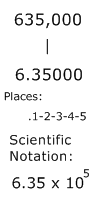What is Scientific Notation with Negative Exponents?
To express a decimal in scientific notation, you need to use negative exponents and use a number between one and ten.
Scientific Notation with Negative Exponents – Example 1
For example, the number .000387 is written in scientific notation as 3.87 × 10-4.
Determining the exponent
If your given number is a decimal, you need to move the decimal point to the right and count the number of places to the left.
You can count the decimal places to the left as shown in the illustration below:

As you can see in the illustration above, you need to use scientific notation with a negative exponent for your answer of 3.87 × 10-4
Scientific Notation Quiz
Instructions: For questions 1 to 5, express the numbers in scientific notation, using negative exponents where necessary. For questions 6 to 10, express the numbers as integers or decimals.
[WpProQuiz 27]What is Scientific Notation?
Scientific notation means that you express a decimal as a number between 1 and 10 multiplied by 10m.
Example 2
In scientific notation, you need to remember to multiply by a power of 10.
For example, the number 635,000 is written in scientific notation as 6.35 × 105.
Count the decimal places
The first step is to move the decimal point to the left, and then count the number of places to the right.
You can count the decimal places as shown in the illustration below:

Shortcut Method
So, the amount of decimal places that you move is the same number that you use for your exponent.
The exponent also correlates to the amount of zeroes that are to be placed after the 1 when we multiply the power of ten.
105 = 10 × 10 × 10 × 10 × 10 = 100,000
In other words, 100,000 has 5 zeroes so it is equal to 105.
You may need to change numbers to or from scientific notation on your exam.
Scientific Notation – Multiplication
You may see problems that involve multiplication with numbers in scientific notation.
Look at the following example:
(3 × 102) × (2 × 104) = ?
To solve multiplication problems like this one, multiply the integers first.
STep 1 – Multiply the ingeters
In our problem, the integers are 3 and 2, so do the multiplication:
3 × 2 = 6
Step 2 – Add the exponents
Then you need to remember to add the exponents when multiplying powers of 10.
So, 102 × 104 = 106
Step 3 – Combine for the scientific notation
Finally, put the two results together for your answer.
(3 × 102)(2 × 104) = 6 × 106
Scientific Notation – Advanced Questions
Notice that you may also see multiplication problems presented like this:
(3 × 102)(2 × 104) = ?
Remember that the times sign between the parentheses is sometimes omitted.
(3 × 102) × (2 × 104) = (3 × 102)(2 × 104)
Scientific Notation – Division
You may also see problems that involve division with numbers in scientific notation.
Look at the following example:
(9 × 107) ÷ (3 × 103) = ?
Step 1 – Divide the integers
First you need to divide the integers.
9 ÷ 3 = 3
Step 2 – Subtract the exponents
When we divide powers of ten, we need to subtract the exponents.
So, 107 ÷ 103 = 104
Step 3 – Combine for the Scientific Notation
Then combine the results for your answer.
(9 ÷ 107)(3 ÷ 103) = 3 × 104
You may also want to visit our page on decimals and our post on exponent laws.
